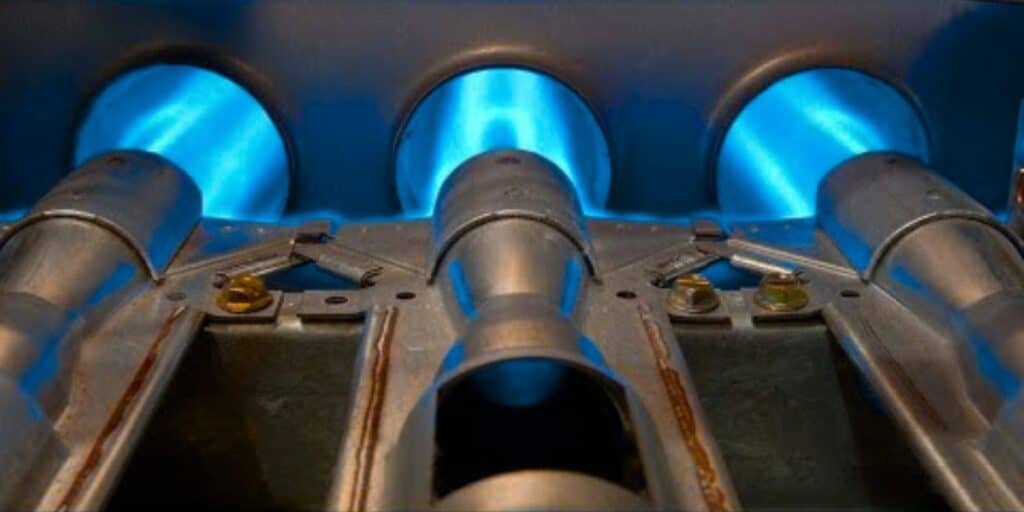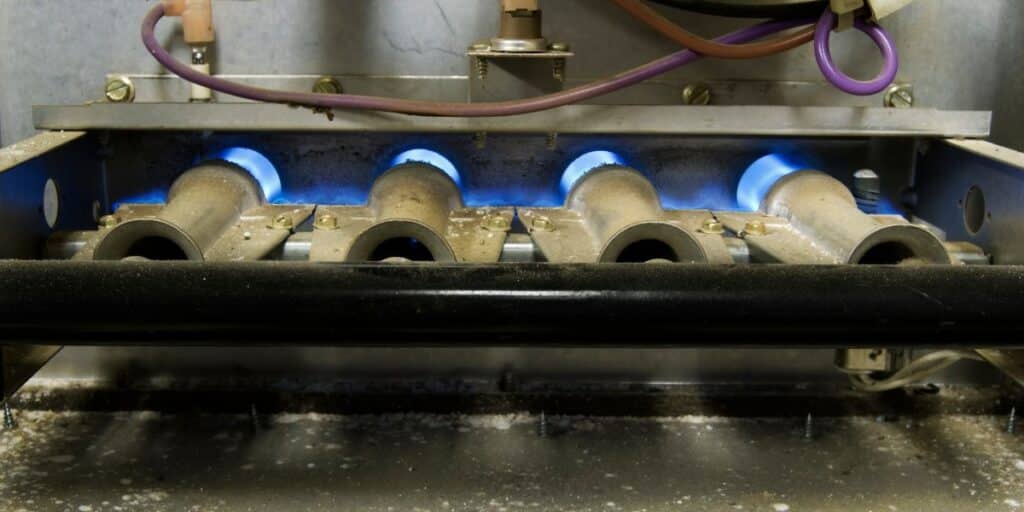Maintaining a healthy, clean furnace is critical for efficient, effective, and safe operation. The color of the gas burner flame is a key indicator of your furnace’s condition. Usually, a bright blue flame is expected, but other colors like yellow and orange may appear, signaling potential issues. This comprehensive guide will explore the causes, symptoms, and how to fix an orange flame on a gas furnace.
Ideal Furnace Flame Color
The standard color for a furnace flame is a shade of blue, occasionally with a hint of yellow at the core.

A bright blue flame signifies complete combustion, offering a strong and efficient burn. If the flame deviates from blue, it may indicate an underlying issue with your natural gas combustion process.
Is an Orange flame on a Furnace dangerous?
Yellow or orange flames are warning signs of incomplete or inefficient combustion. Such colors suggest that your burner is not receiving sufficient air for complete combustion, producing carbon monoxide – a colorless, tasteless, and potentially lethal gas.
Carbon monoxide (CO) is a serious byproduct of improper combustion. Known as the ‘silent killer,’ CO is undetectable by taste, smell, or sight but can cause symptoms like headaches, nausea, hallucinations, and even blackouts.
According to the CDC, carbon monoxide poisoning claims nearly 420 lives annually in the U.S. and causes over 100,000 emergency room visits. This highlights the critical need for proper combustion and flame color monitoring in furnaces.
What causes the orange flame?
Understanding the causes of orange and yellow flames in a gas furnaces requires a closer look at the factors influencing the combustion process.
Improper Orifices
The size and compatibility of orifices in a gas furnace play a crucial role in determining flame color.
Orifices regulate gas flow into the combustion chamber, and their sizing is integral to maintaining the correct fuel-to-air ratio. This ratio can be imbalanced if the orifice is not correctly sized for the type of gas (such as natural gas or propane).
An oversized orifice produces a rich gas mixture, producing yellow or orange flames, while an undersized orifice restricts gas flow, causing a lean mixture.
Regular inspections and maintenance are vital to ensure the orifices are appropriately sized, thus maintaining the furnace’s efficiency and safety.
Fuel Greases
Over time, furnaces can accumulate particles, grease, or oil in the burner assembly or gas lines. This buildup can partially obstruct the gas flow, leading to incomplete combustion and the resulting orange flame.
These clogs disrupt the smooth flow of gas, creating an inconsistent and inefficient combustion process.
Regular cleaning and servicing are essential in this regard. Disassembling and thoroughly cleaning the burner assembly and gas lines removes any accumulated debris, restoring efficient and safe furnace operation.
Faulty Air Shutters
Air shutters and gas valves in a furnace control the amount of air mixed with the gas before combustion.
The proper functioning of these components is essential for complete combustion. If these parts are damaged, incorrectly adjusted, or unsuitable for the furnace model, they can hinder the optimal air and gas mix. This can lead to either too much air (creating a lean burn) or too little air (resulting in a rich burn), changing the flame color to yellow or orange.
Regular inspection, adjustment, and replacement of these components, as needed, are crucial. Professional calibration ensures optimal air-to-gas ratio, promoting efficient and safe combustion in the furnace.
Addressing Furnace Orange Flame Color: Effective Solutions
When confronted with furnace flame color issues, particularly yellow or orange flames, it’s essential to take a systematic approach to identify and solve the underlying problems. This can be accomplished through targeted solutions, each addressing a specific furnace maintenance and repair aspect.
Conduct a Thorough Inspection
The first step in resolving flame color issues is to conduct a comprehensive inspection of the furnace system.
This involves checking for problems in the gas burner. Identifying the exact cause of the problem is crucial, as it dictates the subsequent course of action.

Whether it’s a clogged gas line, a faulty valve, or an improperly sized orifice, understanding the root cause is key to effective resolution.
Replace or Repair Orifices and Valves
Once the inspection identifies issues with orifices or valves, replacing or repairing these components is the next step. Ensuring that orifices and valves are compatible with the furnace system and are functioning correctly is vital for maintaining the proper fuel-to-air ratio.
Replacing worn-out or incorrect orifices and valves can restore the furnace to its optimal operating condition, thus correcting the flame color.
Regular Cleaning
Regularly cleaning the gas furnace, particularly the burner area, is essential to prevent and address flame discoloration.
Over time, grease and other residues can build up, leading to clogs that affect combustion. By regularly cleaning these areas, homeowners can ensure an unobstructed fuel supply, which is crucial for maintaining the correct flame color and efficient furnace operation.
In some cases, furnace issues may be complex or beyond the scope of regular maintenance and DIY fixes. In such instances, it’s advisable to seek professional assistance.
Preventive Measures to Avoid Orange Flame Color
To prevent the orange flame color in a gas furnace, it’s important to implement a series of preventive measures. These measures ensure the furnace operates efficiently and safely, reducing the risk of issues leading to incorrect flame colors.
Let’s explore these preventive strategies in more detail.
- Install Carbon Monoxide Detectors: These devices can alert you to dangerous CO levels in your home.
- Regular Maintenance: Schedule professional maintenance checks to ensure your furnace is in optimal condition.
- Use Appropriate Equipment: Always use equipment designed for your specific furnace type to avoid combustion issues.
- Monitor Flame Color: Keep an eye on the flame color and address any changes promptly.
- Keep the burner Clean: Regular cleaning can prevent blockages that lead to incomplete combustion.
Ensuring a consistently blue flame in your gas furnace is crucial for safety and efficiency. You can maintain a safe and effective furnace by understanding the causes and how to fix an orange flames and taking preventive measures. Remember, timely action and regular maintenance are your best defenses against potential dangers associated with furnace operation.






